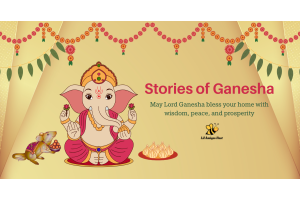Things you can teach your kids about Kumbh Mela!

Kumbh Mela, one of India's most significant and ancient cultural and religious festivals, is a treasure trove of history, spirituality, and traditions. Recognized as the world's largest peaceful gathering of humanity, it offers countless lessons for children. Introducing kids to the multifaceted aspects of Kumbh Mela can help them understand its cultural importance and inspire them to appreciate diversity, spirituality, and unity in diversity. If, as a parent, you are looking for great storybooks, mythological tales, or moral stories, be sure to check out our collection here.
1. The Origin and Significance of Kumbh Mela
Kumbh Mela’s origins lie in Hindu mythology, specifically the story of the Samudra Manthan, or the churning of the ocean of milk. You can explain to kids how gods (Devas) and demons (Asuras) churned the ocean to extract the nectar of immortality (Amrit). During this process, a few drops of nectar fell at four locations—Prayagraj, Haridwar, Nashik, and Ujjain—where the Kumbh Mela is held in rotation.
Teaching kids this mythological story not only piques their interest in Indian mythology but also helps them understand the deeper spiritual meaning behind the festival: the quest for immortality and the victory of good over evil.
2. The Rituals and Practices
Kumbh Mela is a confluence of rituals, spirituality, and devotion. You can explain the significance of the holy dip in sacred rivers like the Ganga, Yamuna, and the mythical Saraswati. Teach kids how this act symbolizes the purification of the soul and the washing away of sins.
Talk about other rituals like:
- Yajnas (Sacrificial offerings): Performed to seek divine blessings.
- Satsangs (Spiritual discourses): Where saints and gurus share wisdom.
- Charity: Encouraging acts of kindness and generosity.
These lessons emphasize the importance of faith, self-purification, and helping others, which are universal values transcending religious boundaries.
3. The Cultural Diversity of Kumbh Mela
One of the most fascinating aspects of Kumbh Mela is its diversity. Pilgrims, saints, and travelers from all walks of life, backgrounds, and nationalities gather at the event. You can highlight how this festival truly reflects India’s unity in diversity.
Teach kids about the different akharas (monastic orders) that participate in the festival and their unique traditions. Introduce them to the Naga Sadhus, who are ascetic warriors, and explain their austere lifestyle and dedication to spirituality. This fosters an appreciation for different cultures and ways of life.
4. The Science and Planning Behind the Event
Kumbh Mela is a massive logistical undertaking. From setting up temporary cities to managing millions of pilgrims, the event showcases incredible planning and coordination. Share fascinating facts like how temporary bridges, hospitals, and sanitation systems are built to accommodate such a large gathering.
Teaching kids about this aspect can instill awe and respect for the efforts behind organizing large-scale events. It also introduces them to the importance of teamwork, infrastructure development, and sustainable practices in managing resources.
5. Lessons in Faith and Devotion
Kumbh Mela is an embodiment of unwavering faith. Millions of people travel long distances, often enduring hardships, to participate in this sacred gathering. Explain to kids how faith can inspire perseverance and a sense of purpose. You can also talk about the role of devotion in connecting individuals to something greater than themselves.
This lesson is particularly valuable in teaching resilience, patience, and the strength of belief, applicable in various aspects of life.
6. Spirituality Beyond Religion
While Kumbh Mela is rooted in Hindu traditions, its core principles—seeking knowledge, self-purification, and community—are universal. Introduce kids to the idea of spirituality as a way to understand themselves and their connection to the world. You can talk about how meditation, yoga, and reflection are integral parts of the event, promoting peace and mindfulness.
7. Environmental Awareness
Rivers play a central role in Kumbh Mela, and this is a great opportunity to teach kids about the importance of preserving natural resources. Discuss the significance of rivers in Indian culture and how they are considered sacred. Highlight the efforts being made to clean and rejuvenate rivers like the Ganga.
Encourage kids to take small steps in their own lives to protect the environment, such as reducing plastic usage, conserving water, and planting trees. This makes the connection between cultural heritage and environmental responsibility.
8. The Vibrant Traditions of Art and Music
Kumbh Mela is not just about rituals; it’s also a celebration of art, music, and storytelling. Traditional folk songs, dances, and performances are an integral part of the event. Introduce kids to these cultural expressions, helping them understand the importance of preserving art forms.
You can even organize an activity where they create their own artwork inspired by the festival, fostering creativity and a deeper connection to the topic.
9. Global Recognition
Kumbh Mela has been recognized by UNESCO as an Intangible Cultural Heritage of Humanity. Teach kids why this recognition is significant and how it brings global attention to India’s rich heritage. This instills pride in their cultural roots and a sense of responsibility to protect and promote their traditions.
10. Learning Values Through Stories
Kumbh Mela is full of inspiring stories of pilgrims and saints. Share anecdotes about individuals who have shown immense devotion, generosity, or wisdom during the festival. These stories can serve as life lessons for kids, teaching values like compassion, humility, and the importance of community.
11. The Role of Technology in Modern Kumbh Melas
In today’s digital age, even ancient traditions like Kumbh Mela are adapting. From drone surveillance for crowd management to apps providing real-time updates for pilgrims, technology plays a crucial role. Teach kids how technology can be used positively to preserve and enhance cultural experiences.
12. Encourage Participation and Curiosity
If possible, take your kids to a Kumbh Mela or a smaller regional fair inspired by it. Experiencing the event firsthand can leave a lasting impression. Encourage them to ask questions, observe the rituals, and interact with people from different backgrounds.
If visiting isn’t feasible, you can organize virtual tours or watch documentaries about the event together. This helps them engage with the topic actively rather than passively.
13. Connection to Indian Festivals and Heritage
Kumbh Mela is a part of India’s broader festival culture, where spirituality and celebration often go hand in hand. Compare it to other festivals like Diwali or Holi, showing how each has its unique significance yet shares common values of unity, joy, and devotion.
14. Fostering Gratitude and Reflection
Amid the hustle and bustle of Kumbh Mela, moments of quiet reflection are encouraged. Teach kids the importance of gratitude for the blessings in their lives. Encourage them to write about what they’ve learned or reflect on their experiences, fostering self-awareness and mindfulness.
Conclusion
Teaching your kids about Kumbh Mela is more than just introducing them to a festival; it’s about imparting lessons on faith, diversity, resilience, and environmental stewardship. It’s a gateway to understanding India’s rich cultural heritage and the universal values it promotes. By engaging them in stories, activities, and discussions, you can ensure they not only appreciate this grand tradition but also carry forward its essence in their own lives.
Kumbh Mela 2025 will be an excellent opportunity for parents to connect their children with this incredible Indian festival. Through the lens of parenting, you can use this event to teach values rooted in Indian culture and spirituality.


























